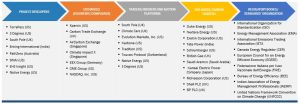Credit Exchanges Securities
Carbon credit exchanges are online marketplaces where individuals and businesses can purchase and trade carbon credits. Each carbon credit represents one ton of carbon dioxide or another greenhouse gas reduced, stored, or avoided, with a particular credit type depending on its underlying source. These credits can be used for compliance with government emissions reduction requirements or as a voluntary tool to lower a company’s environmental footprint.
Currently, the market for carbon credits is primarily a voluntary one. Companies may choose to buy a credit from a project that is reducing emissions in order to offset their own, or they can use the credits as a way of complying with a government-mandated emissions reduction requirement such as California’s cap-and-trade system.

There are also a number of ways that carbon credit exchange can be created and traded, with each one carrying different values. For instance, carbon credits can be generated through projects that reduce emissions by investing in renewable energy sources or through reforestation. The value of a specific credit depends on its attributes, such as the type of project it stems from, the geographical location of the project, the vintage of the project (older projects are generally cheaper) and any additional benefits that the project may provide to society such as biodiversity or water quality.
Carbon Credit Exchanges Securities
The global climate change community is working to create a more efficient and regulated carbon credit market. A key component of this effort is the development of standards and a framework that ensures carbon credit markets are safe and well-functioning, as discussed at this year’s COP27 climate summit. The International Civil Aviation Organization (ICAO) has been tasked with developing these standards, which are expected to be completed by 2022.
In order to achieve these goals, carbon credit markets must have high levels of integrity and transparency. Among other things, this will mean creating a “core carbon principles” and attribute taxonomy to help buyers assess the quality of carbon credits before making purchases. It will also mean creating liquid reference contracts that can be used to price over-the-counter trades.
With Nasdaq’s trading technology, carbon credits can be bought and sold on a trusted platform that will scale as the market grows. Our platform matches buyers and sellers based on multiple parameters and reduces counterparty risk for both participants.
Join Mikkel Larsen, CEO of Climate Impact X, Virginie Barbot, Head of Southeast Asia and Pacific at Nasdaq Marketplace Services and Jill Malandro, Global Markets Reporter at Nasdaq as they discuss the current state of carbon credit markets and how our technology fits in this space. Nasdaq’s trading technology helps to establish market norms based on best practices from other capital markets, while enabling new asset types and matching models. Its scalable architecture will also allow for additional asset types to be added to the platform as the carbon market continues to develop and evolve.